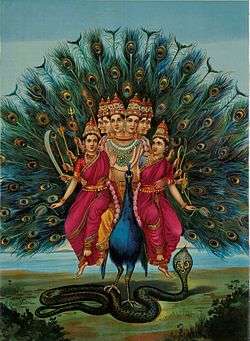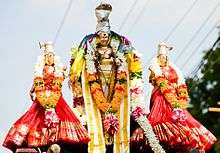Valli
Vaḷḷi (Tamil: வள்ளி) ("Creeper, Sweet Potato Plant")[1] is a Hindu goddess and the consort of the god Kartikeya. Valli is a tribal head girl, who lead a life as a huntress. Murugan the war god belongs to the mountain regions also known as Kurunji the same place where valli belongs.
| Part of the series on |
| Kaumaram |
|---|
 |
|
Six sacred abodes
|
|
| Valli | |
|---|---|
Goddess of Aspiration and power of will | |
 Murugan with Valli (left) seated on his right lap, Raja Ravi Varma painting | |
| Tamil script | வள்ளி |
| Affiliation | Devi, sometimes Kaumari |
| Abode | Skandaloka |
| Mount | Deer |
| Parents | Nambirajan (adoptive father) |
| Consort | Karthikeya |
Vaḷḷi is used to refer to many tribal or indigenous peoples' goddesses in Tamil Nadu and Kerala and by the Rodiya and Vedda peoples of Sri Lanka.
Vaḷḷi is also known as Pongi at Vallimalai in Vellore, Tamil Nadu, and the pond from which she drew water to quench the thirst of Murugan is still there. This pond, though in an open ground, does not receive the rays of the sun. Vedda still inhabit Kataragama region and there are temples dedicated to the mountain god Murugan in this region of Sri Lanka.
Birth
In ancient times, the mountainous regions in South India were ruled by various tribes. The chief of the Kuravar tribe, Nambi Rajan and his wife prayed to the mountain god Murugan for a girl-child. Their prayers were answered, resulting in the birth of a girl named Valli. She grew up as the princess of the mountain tribe. Some myths state that Valli was born from a doe when a sage laid eyes on it during a momentary lapse in his meditation.
According to Sri Lankan mythology, the events occurred among the Veddah people near Kataragama, Sri Lanka. However, South Indian Puranas state that Kataragama was the place where Murugan stationed his army during his war with Surapadman.
Divine revelation

Valli had her heart and soul dedicated to Murugan and would always pray with fervent devotion and love, to be with him. Once, the tribal chief planned to develop a field for growing thinai (foxtail millet), and assigned Valli in charge of its protection from pests. Moved by Valli's devotion, Murugan met her in the form of a handsome tribal hunter, who had lost his way on a hunting chase. This form of Murugan called the 'Veduvan Kolam' is worshipped at the Palaniapaar temple at Belukurichi. Valli did not recognize the stranger and promptly asked him to leave the place. Seeing the chief arriving at the field with honey and fruits for Valli, Murugan turned himself into a tree. After the chief and his followers left, the god changed back into his hunter form and proposed his love to Valli.
The princess who had only Murugan in her heart, was infuriated at the proposal and lashed out at the hunter. When the chief and his followers returned to the place, Murugan disguised as an old man. The chief, on seeing the aged man, requested him to stay with Valli till he and his hunting party returned.
The old man was hungry and asked Valli for food; she gave him a mixture of the millet flour and honey. However, it made him thirsty and he asked for water. She provided water from a nearby stream. He jokingly remarked that she had satisfied his thirst and she could quench his thirst for a companion. Valli was angered again and started to leave the place. He requested assistance from his divine brother, Ganesha, who appeared as a wild elephant at that time. On seeing the wild elephant, Valli was scared and ran back to the old man, pleading him to save her from the elephant. Murugan proposed to save her only if she agreed to marry him. In the heat of the moment, she agrees and he reveals his true form. It was then Valli realised that it was her beloved Lord, who was with her all the time.
The wedding
After the millet harvest was over, the chief with his daughter and entourage returned to their native land. Murugan returned for Valli in the guise of the aged man and the couple spent time away from Valli's family. Nambi Raja on being alerted about Valli's absence, flew into rage and went in search of her. When the search party finally found Valli with Murugan, the chief and his men shot arrows at Murugan, but they all failed to even touch the God and instead, the chief and his sons fell lifeless. Valli was disheartened to see the lifeless bodies of her kith and kin, and requested the god to bring them back to life. Murugan instructed her to revive them herself; by her mere touch everyone was brought back to life. The chief Nambi Raja and his tribesmen realized that it was Murugan, in the form of the old man and prayed to Him. Murugan took his true form and blessed the tribesmen, and the chief conducted the marriage of his daughter and Murugan.
This place came to be known as Vallimalai, the divine place were Murugan and Valli spent their time in courtship and eventually got married. It is located in Vellore District of Tamil Nadu state, in South India.
After their wedding, Murugan and Valli, moved to Thiruthani, which is one of the Arupadai Veedu (the six battle camps) of the god.
Legends and textual references
The south-Indian manuscripts of the Sanskrit scripture Skanda Purana mentions Devasena and Valli as daughters of the god Vishnu in a previous life. Thus, Murugan is regarded as the son-in-law of Vishnu as their husband. An interpolation in the southern recensions of the scripture as well as the Kanda Purana (the Tamil version of the Sanskrit Skanda Purana) narrate the story of the marriage of the two maidens to Murugan. The two maidens are fated to be married to the god. The elder sister Devasena is born as Amritavalli. She follows the path of traditional Hindu rituals and practices to gain her husband. Appeased by her penance, Indra adopts her as his daughter and marries her to Murugan in an arranged marriage, following custom, after Kartikeya triumphs over the demons. The Kanda Purana describes Devayanai (Devasena) as the daughter of Indra, without any mention of adoption. The couple is described as taking their abode in the hills of Thiruttani, where one of Murugan's chief temples, Thiruthani Murugan Temple, stands. Another version describes the couple as residing in heaven, the abode of the gods. Meanwhile, Valli is born as Sundaravalli. She is adopted by a tribal chieftain and grows up as a huntress. Murugan wins Valli's hand and takes her to Thiruttani. The god is worshipped at the Thiruthani temple, flanked by Devasena on his left and Valli on his right. In the end, the trio settles in the abode of the gods and lives in harmony thereafter.[2][3] An alternate ending found in Sri Lankan lore describes Murugan as staying on in the forest with Valli after their wedding at Kataragama, where his temple stands. Devayanai tries in vain to compel the god to return to the abode of the gods, but finally joins Kartikeya and Valli to reside in Kataragama.[4]
Unlike the Skanda Purana which talks about harmony between Devasena and Valli, the Paripatal – part of Tamil Sangam literature – speaks about conflict, resulting in a battle between Devayanai's royal soldiers and Valli's hunter clan, which the latter win. Folk ecal (a folk poem, presented as a dialogue of two persons) tradition also talks about the mistrust and quarrel between the co-wives. In one version - where Devayanai is the elder sister of Valli, Valli tries to woo Murugan, before Devayanai's marriage. As per tradition, the elder sister has to be married off first. Infuriated, Devayanai curses Valli to be born in the forest in her next life, and the curse is then fulfilled when Valli is born as a huntress.[5] In the Jayantipura Mahatmya, the details of which correspond to most of those found in the Skanda Purana tale, Devasena and Valli are married to Kartikeya from primal times. However, in this version, the god condemns Valli to be born on earth as punishment for mocking her sister Devayanai.[6] The Thirumurugatrupadai from Sangam literature describes Murugan being accompanied by his chaste wife Devayanai and honoured by a procession of gods and rishis (sages).[7]
See also
- Muruga
- Six Abodes of Muruga
References
- Dictionary definition is: வள்ளி (vaḷḷi), s. a plant, convolvulus batatas; 2. a winding plant, dioscorea sativa, படர்கொடி; 3. a ratan-shield, பிரப்பங் கேடகம்; 4. a jewel, ஆபரணம்; 5. a bracelet, கைவளை; 6. a kind of play, a dance, ஓர் கூத்து; 7. a consort of Subramanya. Fabricius, Johann Philipp. J. P. Fabricius's Tamil and English dictionary. 4th ed., rev.and enl. Tranquebar: Evangelical Lutheran Mission Pub. House, p,855, online (1972) edition
- Clothey pp. 83–84
- Handelman pp. 44–45
- Handelman p. 55
- Handelman p. 56
- Clothey p. 225
- Clothey pp. 64–5
- Ancient myths of the aborigines of Kerala
- Tiru Murugan (Madras: International Institute of Tamil Studies) (1981). "Murugan and Valli romance". Kamil V. Zvelebil. Retrieved 7 May 2008.
